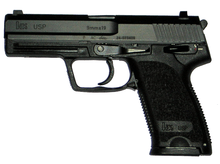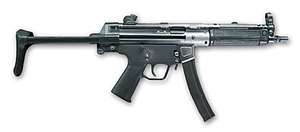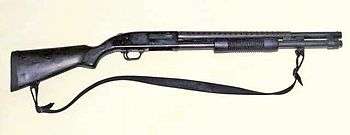Federal Police (Mexico)
The Federal Police (Spanish: Policía Federal, PF), formerly known as the Policía Federal Preventiva (Federal Preventive Police),[3] was a Mexican national police force. It was under the authority of the Department of Security and Civil Protection. They were sometimes referred to by the slang term "Federales" or "Mexican feds" by some U.S. agents and media. Typically, agents of the Federal Police are heavily armed and wear dark blue, black, or gray combat fatigues. The Federal Police was officially dissolved and absorbed to the National Guard, a new national police institution created by president Andres Manuel Lopez Obrador, on 1 October 2019.
| Federal Police Policía Federal | |
|---|---|
 | |
| Abbreviation | PF |
| Agency overview | |
| Formed | June 2, 1928 |
| Preceding agencies |
|
| Dissolved | October 1, 2019 |
| Superseding agency | National Guard |
| Employees | 37,331 |
| Annual budget | US$34.6 billion (2010) |
| Jurisdictional structure | |
| Federal agency | Mexico |
| Operations jurisdiction | Mexico |
| Governing body | Secretariat of Security and Civilian Protection |
| General nature | |
| Operational structure | |
| Headquarters | Mexico City |
| Agency executive |
|
| Parent agency | Department of the Interior |
| Notables | |
| Anniversary |
|
| Website | |
| [2] (Spanish) | |
The Federal Preventive Police was created by the merger of four other federal organizations in 1998 and 1999 in order to better co-ordinate the fight against the growing threat of drug cartels. The agency merged the Federal Highway Police, the Fiscal Police, an Interior Ministry intelligence unit called the Investigation and National Security Center, and military personnel transferred en masse from the Mexican Army's 3rd Military Police Brigade.
On account of its heavily armed agents, its culture, and its origins, the Federal Police as a whole may be considered a gendarmerie. However, two of the seven "divisions" (i.e. branches of service) of the Federal Police have particularly military characteristics: The Federal Forces Division and the Gendarmerie Division. The Gendarmerie Division was created in 2014, and is legally defined as a military/police force within the Federal Police.
There is an investigation division within the Federal Police. Investigation of federal crimes can also be handled by the Federal Ministerial Police directed by the Attorney General of Mexico.[4]
History
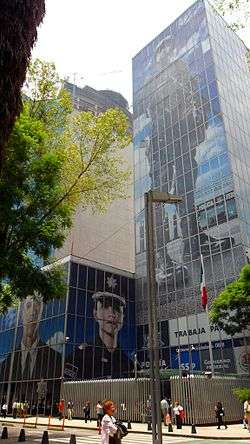
On May 29, 2009, the Federal Preventive Police name was changed to Federal Police, and some duties were added to it. The Federal Police was created as the main Federal Preventive Police in 1999 by the initiative of President Ernesto Zedillo (1994–2000) to prevent and combat and to enforce the law that drugs will not run around on Mexico's streets. The PF has been assuming its authority in stages over time, as its budget has grown and it has combined and reorganized police departments from major agencies such as those for migration, treasury, and highways. Many large bus stations and airports in Mexico are assigned a PF detachment.
Public Safety Secretary Genaro García Luna hoped to reform the nation's long-troubled police. Among other steps, he consolidated several agencies into a Federal Police force of nearly 25,000.[5]
The Federal Police celebrates its anniversary on July 13 every year (Federal Police Day), with its history dating to 1928 as the successor of the agencies mentioned above.
Calderón's administration
When Felipe Calderón took office as President in 2006, there were roughly half a dozen drug cartels in Mexico. Each of the organizations were large and dominated huge parts of Mexico's territorial landscape, and operated internationally and overseas as well.[6] When Calderón assumed the presidency, he realized that he could not rely on the federal police nor the intelligence agencies to restore order and crack down the logistics of the mafias.[6] Over several decades, the cartels had bribed police commanders and top politicians; and often riddled with corruption, state authorities would not only fail to cooperate with other authorities in distinct federal levels, but would actively protect the cartels and their leaders. With limited options available, Calderón turned to the Mexican Armed Forces, which, because of its limited involvement in acting against the cartels, remained relatively immune to corruption and organized crime infiltration.[6] He then moved the military to parts of Mexico most plagued by drug-violence to target, capture, and – if necessary – kill the leaders of the drug trafficking organizations. Yet, the president understood that the military could not fight the cartels alone and needed cops to rely on for patrolling, collecting intelligence information, and gathering evidences necessary to prosecute drug traffickers.[6]
With the argument that he was tired of the corruption, Calderón abolished the AFI agency created in May 2009 and created an entirely new police force.[6] The new force has formed part of Mexico's first national crime information system, which stores the fingerprints of everyone arrested in the country. They also have assumed the role of the Army in several parts of the country. According to The New York Times, the federal police has avoided "any serious incidents of corruption."[6]
On October 21, 2008, President Felipe Calderón proposed to break the former Federal Preventive Police to replace it with a different organization, because "the PFP has not yielded the expected results and has not been a strong institution capable of serving as a model for all police services in the country."[7][8] The new corporation became the Federal Police, and it provides support to the police as to the Federal District, states and municipalities. This decision was said to be not entirely unexpected, given the insufficient number of convictions, the alarming increase of violence, abductions and cases of corruption and complicity with organized crime elements.[9][10][11][12][13][14]
Peña Nieto's administration
In 2012, it was reported that President Enrique Peña Nieto's government had proposed the creation of a new unit to replace all Federal Police duties.[15] Federal Police would not be disbanded but would be assigned to special tasks & missions. Additional information on Mexico's planned Gendarmerie ("The 'National Gendarmerie' and Mexico's Crime Fighting Plans," MexiData.info, Dec. 24, 2012).[16]
The final product is the 2014 creation of the Federal Police's Gendarmerie Division, with 5,000 police agents. Its focus is on providing ongoing public security in areas with heavy criminal activities and providing border security. It is also expected to reinforce state, city and municipal police forces when the need arises. It is one of the seven constituent divisions of the Federal Police reporting directly to the Commissioner, and the newest to be raised.
The National Gendarmerie is defined as a military grade force within the Federal Police.
Lopez Obrador's administration
Before becoming President of Mexico, Andrés Manuel López Obrador campaigned on a promise to take the military off the streets of Mexico.[17] Shortly after getting into office, Obrador released a plan to create the National Guard under control of the Mexican Armed Forces which would be in charge of "preventing and combating crime".[17][18] Obrador stated that the new National Guard would be critical to solving Mexico's ongoing security crisis.[19][20]
On 28 February, the Mexico's General Congress voted to approve a 60,000-member national guard.[20] On 30 June 2019, the National Guard was officially established in the Constitution of Mexico.[21]
The new National Guard, de facto successor to a similar formation raised in 1821 and abolished in 1935, is composed today of personnel from parts of both the National Gendarmerie and Federal Forces Divisions of the Federal Police.
Institutional goals
Vision
Being an institution committed to the society in preventing crime and fighting crime, preserving the integrity and heritage of the people, peace and order and the rule of law, whose principles attached to this of legality, efficiency, professionalism and honesty, with full respect for human rights. Maintain and strengthen the social communications strategy and media relations that allows the dissemination of timely and accurate actions and work of the Federal Police.
Strategy
The PF was established as a central element of the strategy against organized crime and criminality in Mexico, not only to prevent crimes and federal jurisdiction at the federal level, but to become an institution of excellence, capable of cooperating with local police and prosecutors in investigating the crimes of high social impact. The strategic objectives are:
- Compliance with legal framework to combat organized crime and drugs.
- The establishment of the National System of Public Security.
- The evaluation and adjustment of the strategy for drug control in Mexico.
On July 10, 2008, the Mexican government announced the intention of doubling the number of policemen in the PF to escalate the war against drug trafficking. The recruitment campaign has already begun and includes the university community.[22][23]
Strategic objectives
- Preventing and combating crime commission to ensure peace and public order.
- Fight corruption, to purify and dignify the police.
- Strengthen the professionalism of the members of the Institution.
- Improve public perception of the institutional activities.
- Promote citizen participation in crime prevention.
- Consolidated as the country's largest institution in the field.
- Strengthen its organizational structure and functional.
- Manage resources efficiently.
- Increase and strengthen the operational deployment at the national level.
- Strengthening intelligence activities.
- Strengthen inter-agency coordination mechanisms with the three levels of government.
- Promote the updating of the legal framework.
- Strengthen and upgrade the technological infrastructure.
Institutional development
The 'Integral Strategy for Crime Prevention and Fight against Crime "is based on a process of reengineering to organizational development, as well as systems and processes in organizational performance, with a cross through the professionalization the creation of three academies in the Ministry of Public Security for the purpose of having Mexican committed to legality, efficiency, professionalism and honesty in this current stage of drug influence to the United States.[24]
- Basic Police School
To generate the training and training students with high school level.
- College research
It is aimed at all those aspiring and active police agents who choose to make them more professional, from academic performance and service in the police pro
Strength
In 2000, the PF had 10,878 agents and staff:
- 4,899 from the Mexican army's 3rd Brigade of the Military Police (Tercera brigada de policía militar), included two military police battalions and an Assault Battalion.
- 4,000 from the Federal Highway Police (Policía Federal de Caminos)
- 1,500 from the Fiscal Police (Policía Fiscal Federal)
- 600 from the Interior Ministry's Center of National Security And Investigation (Centro de Investigación y Seguridad Nacional) – Mexican intelligence agency.
Organization
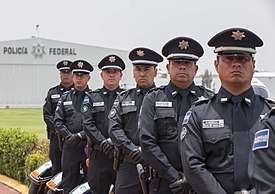
Regulation of the Law of the Federal Police in the Official Gazette of May 17, 2010, to establish the basic organizational structure of this Decentralized Administrative Body, Article 5 of that system, comprising a total of 136 seats of middle and senior management, broken 130 seats structure, as shown below:
- 1 General Commissioner;
- 7 Divisions: Intelligence Research, Regional Security; Scientific, Drug, Federal and Gendarmerie Forces;
- 1 General Secretariat;
- 1 Internal Affairs;
- 20 Coordination;
- 66 DGs;
- 6 DGs in aid to the Chief of the Division of Regional Security;
- 32 State Coordination at the regional level; and
- 1 Head of Internal Affairs.
Commissioner General
- General Vargas Pitt Azian of Legal Affairs
- Directorate General of Information
- Directorate General of Social Communication
- Directorate General of Planning and Coordination
Intelligence Division
- Coordination of Technical Services
- General Directorate of Technical Monitoring Center
- Directorate General of the Center for Risk Alert and Response
- Directorate General for Development and Operation of Coverage
- Covert Operations Coordination
- Directorate General Operations and Infiltration
- Directorate General of Recruitment and Resource Management
- Directorate General for Supervision and Surveillance
- Coordination Analysis and International Liaison
- Directorate General of Analysis and Statistics
- Directorate General for International Police Affairs
- Indicators DG Information Integration
Research Division
- Research Coordination Office
- Directorate General of Tactical Analysis
- General Directorate of Criminal Records and Records
- Directorate General for Crisis Management and Negotiation
- Coordination of Field Research
- DG Research of Crimes against the Security and Integrity of Persons
- Directorate General for Research of Crimes High Impact
- DG Research of Federal Crimes
- Technical Research Coordination and Operation
- Directorate General of Technical Operations
- Directorate General of Operational Intelligence
- Directorate General Tactical Support
Regional Security Division
- DG Personnel
- DG Information
- Directorate General Operations
- Department of Logistics and Training
- Directorate General of Planning and Supervision
- Directorate General of Operational Control
- State Coordinators (32)
- Regional Coordination Zones (5)
- Central Regional Coordination Zone
- Northeast Regional Coordination Zone
- Northwest Regional Coordination Zone
- West Regional Coordination Zone
- Southeast Regional Coordination Zone
Scientific Division
- For the Prevention of Electronic Crimes
- Department Cyber Crimes Prevention
- CERT-MX – Centre of Expertise in Technological Response (Centro Especializado en Respuesta Tecnológica)
- DG Laboratories in Electronics and Forensic Investigation
- Coordination of Technological Innovation
- Directorate General for Emerging Information Technologies
- Department of Infrastructure and Implementation of Technological Processes
- Directorate General for Innovation and Development
- Coordination of Criminology
- Directorate General of Criminal Behavior
- DG Laboratories
- DG Specialties
Drug Division
- Drug Research Coordination Office
- Tactical Analysis Directorate General of Drug
- Directorate General of Records and Registration of Drug Trafficking and Related Crimes
- Liaison Department and Institutional Cooperation
- Field Research Coordination and Technical Drug
- Directorate General of Technical Operation Drug
- Directorate General of Drug Intelligence Operations
- Directorate General Tactical Support against Drug Trafficking and Related Crimes
- Research Coordination Illicit Resources
- Directorate General of Tactical Analysis of Crimes Financial System
- Financial Intelligence Directorate for Prevention
- Prevention Directorate General Operations Illicit Resources
Federal Forces Division
- Coordination for Law and Order Restoration
- Directorate General for Force Protection
- Directorate General for Rescue Operations and Civil Support
- Directorate General of Prison Transfers and Support
- Coordination of Immediate Quick Reaction Forces
- Directorate General of Physical Security
- Directorate General for Quick Action Forces
- Directorate General of the Canine Units
- Coordination of Special Operations
- Directorate General of Intervention
- Directorate General of Explosives
- Directorate General of Special Equipment
National Gendarmerie Division
See article: National Gendarmerie (Mexico)
- Coordination Bureau of the National Gendarmerie
- Directorate General of Planning and Logistics
- Directorate General of Strategic Operations and Special Units of the Gendarmerie
- Directorate General of Social Services and Public Affairs
General Secretary
- Coordination of General Services
- Directorate General of Human Resources
- Directorate General of Financial Resources
- Department of Material Resources
- Air Operations Coordination
- Directorate General Operations
- Directorate General Maintenance
- Directorate General for Aviation and Safety Supervision
- Coordination Technical Support
- Department of Information
- Directorate General of Telecommunications
- Directorate General of Technical Facilities and Maintenance
- Police Coordination System Development
- Control Directorate General Trust
- Directorate General of Civil Service System and Disciplinary
- Directorate-General for Education and Professionalization
Internal Affairs
- Directorate General for Internal Oversight Monitoring and
- Directorate General for Internal Investigation
- Directorate General Accountability
Internal Control
Superior Academy of Public Security of the Federal Police
- Directorate General;
- Directorate-General for Administration;
- Academic Board;
- Preceptory address
- Services Division
Divisions
_cars_at_parade.jpg)
The Policía Federal consists of seven branches of service, known as divisions, administered by a central administration called the General Secretariat (Secretaría General) [25][26]
- Anti-drug Division – División Antidrogas
- Scientific Division – División Científica
- Federal Forces Division – División de Fuerzas Federales
- Intelligence Division – División de Inteligencia
- Investigation Division – División de Investigación
- Regional Security Division – División de Seguridad Regional
- National Gendarmerie Division – División de Gendarmería Nacional
There is also a separate Internal Affairs Unit (Unidad de Asuntos Internos).
2010 included the Policía Federal approx 35,000 civil servants on.[27] A Comisionado General (General Manager), which is used directly by the President of Mexico, heads with wide-ranging powers the institution.[28] Maribel Cervantes Guerrero broke off in February 2012 Facundo Rosas Rosas, who held this office since 2009 .[29]
The Special Operations Group (GOPES) is the police elite counter terror hostage rescue unit.
Ranks
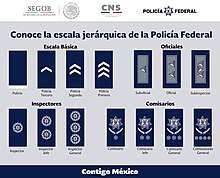
- Policeman/woman – Policía – One bar
- Corporal – Cabo – One chevron
- 2nd Sergeant – Sargento Segundo – Two chevrons
- 1st Sergeant – Sargento Primero – Three chevrons
- Sub-officer – Suboficial – One triangle
- Officer – Oficial – Two triangles
- Sub-inspector – Subinspector – Three triangles
- Inspector – Inspector – One star (eight-pointed)
- Chief Inspector – Inspector Jefe – Two stars (eight-pointed)
- Inspector General – Inspector General – Three stars (eight-pointed)
- Commissioner – Comisario
- Chief Commissioner – Comisario Jefe
- Commissioner General – Comisario General
The ranks from Commissioner to Commissioner General wear more complex rank insignia involving the seven-pointed star of the Federal Police badge above one to four five-pointed stars placed between two stripes.
Equipment
Weapons


Pistols
- Beretta 92F2
- Glock pistol
- Heckler & Koch USP
- Jericho 941
- CZ P-09
Submachine guns
- Colt 9 mm SMG
- Heckler & Koch MP5
- Heckler & Koch MP7
- Heckler & Koch UMP
- Uzi
Assault rifles
- AR-15
- Beretta AR70/90
- Beretta ARX 160
- CZ-805 BREN
- FN FAL
- Galil ACE
- Heckler & Koch G3
Sniper rifles
Machine guns
- FN MAG
- FN Minimi
- Heckler & Koch HK21
- IMI Negev
- M2 Browning
- M60E4
Shotguns
Grenade launchers
Transport
The PF has many vehicles; land, sea and air, it is estimated to own more than 17,000 patrol cars. The exact information regarding transport vehicles and aircraft that comprise the fleet of the Federal Police is classified, to protect the life and efficiency of agents.[30]
Rotary wing and fixed wing pilot training takes place in the school of Naval Aviation located on Las Bajadas, Veracruz.[31]
Aircraft
| Manufacturer | Aircraft | Versions | Type | In Service | Origin | Notes | Image |
|---|---|---|---|---|---|---|---|
| Fixed-wing aircraft | |||||||
| CASA | CASA CN-235 | CN-235-400 | Transport | 2 | 1 on order | .jpg) | |
| Unmanned aerial vehicles | |||||||
| Hydra Technologies | Hydra Technologies S4 Ehécatl | S4B | Observation & Reconnaissance | 12 | Will be supported by 3 Elbit Hermes 900 |  | |
| Elbit Systems | Elbit Hermes 450 | H-450 | Observation & Reconnaissance | 4 | 10 |  | |
| Helicopters | |||||||
| Sikorsky | UH-60 Black Hawk | UH-60M/L | Transport & Air Support | 12 | 3 more on order | .jpg) | |
| Mil | Mil Mi-17 | Mi-171-V | Transport & Air Support | 4 |  | ||
| Eurocopter | Eurocopter AS350 Écureuil | AS350L1 | Reconnaissance & Air Support | 10 | 3 more ordered |  | |
| Eurocopter | Eurocopter EC120 Colibri | EC120 | Transport & Reconnaissance | 3 |  | ||
| Bell Helicopter | Bell 206 | B-206L | Transport & Reconnaissance | 5 | 1 loss | 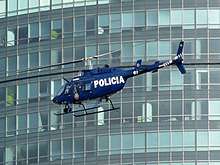 | |
| Bell Helicopter | Bell 412 | B-412EP | Transport, Air Support & Reconnaissance | 3 | Recently introduced, accompanied by one B-412 from the FAM | 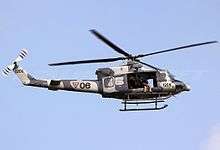 | |
| MD Helicopters | MD 500 | MD 530G | Reconnaissance & Air Support | 7 | Recently introduced, accompanied by one B-412 from the FAM | .jpg) | |
See also
- Attorney General of Mexico
- Crime in Mexico
- Federales
- Grupo de Operaciones Especiales (Mexico)
- Rurales
- Mexican Drug War
- United States Marshals Service
| Wikimedia Commons has media related to Policía Federal. |
References
- "México conmemora el Día del Policía. La Prensa". Laprensa.com.ni. Archived from the original on 2014-03-25. Retrieved 2014-03-25.
- "Comisión Nacional de Seguridad". Archived from the original on 13 December 2014. Retrieved 11 December 2014.
- In a news conference after the Zacatecas prison break in May, spokesman Ricardo Nájera for the Mexican Attorney General stated that the name and acronym PFP (Policia Federal Preventiva) has not been used for a year and a half "Archived copy". Archived from the original on 2017-02-13. Retrieved 2016-11-29.CS1 maint: archived copy as title (link)
- "Archived copy". Archived from the original on 2012-02-25. Retrieved 2012-09-28.CS1 maint: archived copy as title (link)
- "L.A. Times". L.A. Times. 2008-09-15. Retrieved 2014-03-25.
- Bonner, Robert C. (15 April 2012). "Cracking the Mexican Cartels". The New York Times. Archived from the original on 29 August 2012. Retrieved 7 July 2012.
- Merlos, Andrea (2008-10-22). "Pide Calderón 'zar' policiaco" (in Spanish). El Universal. Archived from the original on 2008-10-24. Retrieved 2008-10-23.
- Toni, Cano (2008-10-23). "Calderón quiere una policía lejana a los narcos" (in Spanish). Diario Córdoba. Archived from the original on 2009-02-11. Retrieved 2008-10-23.
- "Relevan a 284 mandos de la Policía Federal Preventiva para depuración" (in Spanish). Notimex. 2007-06-25. Archived from the original on 2009-02-11. Retrieved 2008-10-23.
- Ravelo, Ricardo (2008-08-17). "Las policias: Improvización, caos, desastre" (in Spanish). Democrata – Norte de Mexico. Archived from the original on 2011-07-08. Retrieved 2008-10-23.
- Daniel Blancas Madrigal (2006-09-26). "Arrestan a más federales por el caso Martí" (in Spanish). La Cronica de Hoy. Archived from the original on 2008-10-20. Retrieved 2008-10-23.
- Segura Garnica, Jacinto (2007-04-30). "Gatilleros son empelados administrativos de PFP" (in Spanish). El Mexicano. Retrieved 2008-10-23.
- "Cae mando de PFP por proteger al Rey Zambada" (in Spanish). El Universal. 2008-10-30. Archived from the original on 2008-11-02. Retrieved 2008-11-03.
- González, Maria de la Luz (2008-11-04). "Confirma PGR arraigo de ex comisionado de PFP" (in Spanish). El Universal. Archived from the original on 2008-11-07. Retrieved 2008-11-05.
- "Is it Worth Creating a Gendarmerie in Mexico? - InSight Crime | Organized Crime in the Americas". InSight Crime. 2012-12-10. Archived from the original on 2014-03-25. Retrieved 2014-03-25.
- "The 'National Gendarmerie' and Mexico's Crime Fighting Plans". Mexidata.info. 2008-12-15. Archived from the original on 2014-03-25. Retrieved 2014-03-25.
- Sieff, Kevin; Sheridan, Mary Beth (10 June 2019). "Mexico is sending its new national guard to the Guatemala border. The mission is unclear". The Washington Post. Retrieved 2019-07-14.
- "Plan Nacional de Paz y Seguridad" (PDF). transicion.mx (in Spanish). Retrieved 14 July 2019.
- Semple, Kirk; Villegas, Paulina (28 February 2019). "Mexico Approves 60,000-Strong National Guard. Critics Call It More of the Same". The New York Times. Retrieved 14 July 2019.
- Correa, Catalina Pérez (8 August 2019). "México necesita una Guardia Nacional realmente civil". The New York Times (in Spanish). Retrieved 9 August 2019.
- "Mexico Plan Adds Police To Take On Drug Cartels". Washingtonpost.com. 2008-07-11. Archived from the original on 2014-03-25. Retrieved 2014-03-25.
- La Jornada. "convenio con la PFP para reclutar policías". Jornada.unam.mx. Archived from the original on 2014-03-25. Retrieved 2014-03-25.
- "Comisión Nacional de Seguridad". Archived from the original on 3 March 2016. Retrieved 11 December 2014.
- "Comisión Nacional de Seguridad". Archived from the original on 1 December 2014. Retrieved 11 December 2014.
- "Comisión Nacional de Seguridad". Archived from the original on 31 October 2014. Retrieved 11 December 2014.
- Alex Gertschen: http://www.nzz.ch/nachrichten/politik/international/moral_fuer_den_krieg_ohne_absehbares_ende_1.7458708.html
- "Diario Oficial de la Federación. Cámara de Diputados, 1. Juni 2009; retrieved, 15 April 2012 (PDF; 98 kB, spanisch, Gesetzestext)" (PDF). Archived (PDF) from the original on 12 June 2012. Retrieved 2014-03-25.
- kheinle (2012-02-13). "Justice in Mexico Project, 13 February 2012". Justiceinmexico.org. Archived from the original on 2 March 2014. Retrieved 2014-03-25.
- Transporte Archived 2016-04-12 at the Wayback Machine
- "Entrenamiento de pilotos de la PF". Portalaviacion.vuela.com.mx. Archived from the original on 2012-07-06. Retrieved 2014-03-25.
